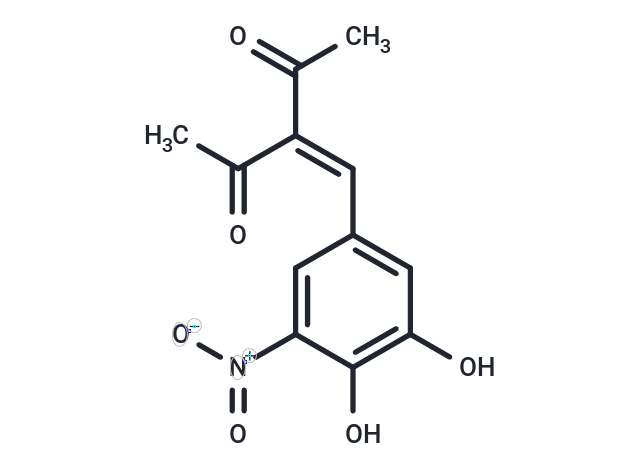Shopping Cart
- Remove All
 Your shopping cart is currently empty
Your shopping cart is currently empty

Nitecapone is a reversible inhibitor of S-COMT (IC50 values of 300 nM in rat liver)

| Pack Size | Price | Availability | Quantity |
|---|---|---|---|
| 1 mg | $41 | In Stock | |
| 5 mg | $103 | In Stock | |
| 10 mg | $173 | In Stock | |
| 25 mg | $293 | In Stock | |
| 50 mg | $412 | In Stock | |
| 100 mg | $567 | In Stock | |
| 200 mg | $772 | In Stock |
| Description | Nitecapone is a reversible inhibitor of S-COMT (IC50 values of 300 nM in rat liver) |
| Targets&IC50 | S-COMT:300 nM |
| In vitro | At high micromolar to millimolar concentrations in in vitro research studies, nitecapone is an effective antioxidant, nitric oxide radical scavenger, and iron chelator that can protect cells from lipid peroxidation[1] |
| In vivo | After single administration, both?nitecapone?and OR-486 reduced mechanical nociceptive thresholds and thermal nociceptive latencies (hot plate test) at 2 and 3 h, regardless of their brain penetration. These effects were still present after chronic treatment with COMT inhibitors for 5 days. Intraplantar injection of carrageenan reduced nociceptive latencies and both COMT inhibitors potentiated this reduction without modifying inflammation. CGP 28014 shortened paw flick latencies. OR-486 did not modify hot plate times in Comt gene deficient mice. Intrathecal?nitecapone?modified neither thermal nor mechanical nociception[2]. |
| Animal Research | Used single and repeated administration of a peripherally restricted, short-acting (nitecapone) and also a centrally acting (3,5-dinitrocatechol, OR-486) COMT inhibitor.?We also tested CGP 28014, an indirect inhibitor of COMT enzyme.?Effects of OR-486 on thermal nociception were also studied in COMT deficient mice.?Effects on spinal pathways were assessed in rats given intrathecal nitecapone[2]. |
| Molecular Weight | 265.22 |
| Formula | C12H11NO6 |
| Cas No. | 116313-94-1 |
| Smiles | CC(=O)C(=Cc1cc(O)c(O)c(c1)[N+]([O-])=O)C(C)=O |
| Relative Density. | 1.451 g/cm3 (Predicted) |
| Storage | Powder: -20°C for 3 years | In solvent: -80°C for 1 year | Shipping with blue ice. | |||||||||||||||
| Solubility Information | DMSO: 2.5 mg/mL (9.43 mM), Sonication is recommended. | |||||||||||||||
Solution Preparation Table | ||||||||||||||||
DMSO
| ||||||||||||||||

Copyright © 2015-2025 TargetMol Chemicals Inc. All Rights Reserved.